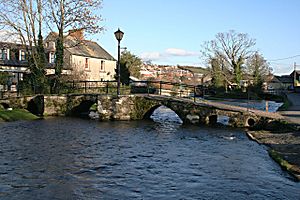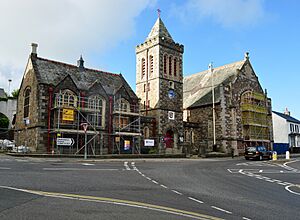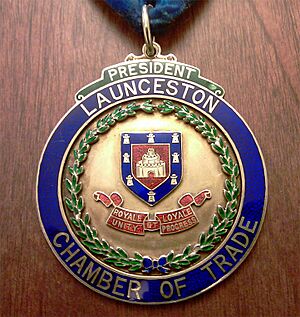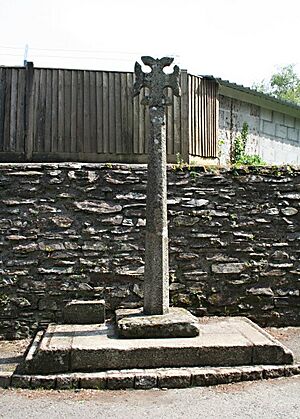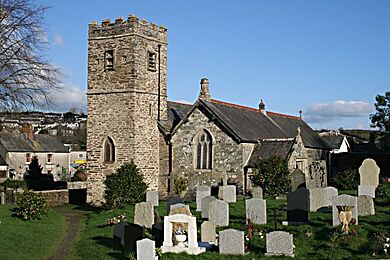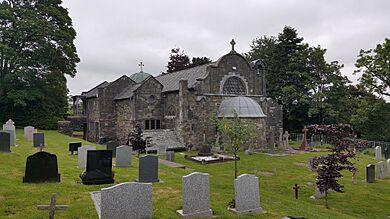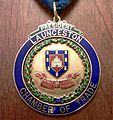Launceston, Cornwall facts for kids
Quick facts for kids Launceston
|
|
|---|---|
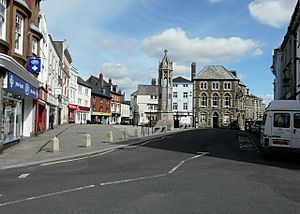 Town Square |
|
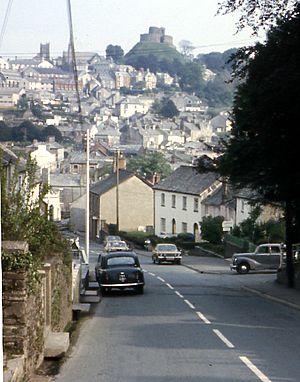 Town centre in 1973 from Saint Stephen's Hill showing the prominent Launceston Castle |
|
| Lua error in Module:Location_map at line 530: Unable to find the specified location map definition: "Module:Location map/data/Cornwall (mainland)" does not exist. | |
| Population | 9,216 (2011 census) |
| Motto | Royale et Loyale |
| OS grid reference | SX335845 |
| Civil parish |
|
| Unitary authority | |
| Ceremonial county | |
| Region | |
| Country | England |
| Sovereign state | United Kingdom |
| Post town | LAUNCESTON |
| Postcode district | PL15 |
| Dialling code | 01566 |
| Police | Devon and Cornwall |
| Fire | Cornwall |
| Ambulance | South Western |
| EU Parliament | South West England |
| UK Parliament |
|
Launceston (pronounced LAHN-stən or LAWN-stən) is a town in Cornwall, England. It is located about 1 mile (1.6 km) west of the River Tamar. This river forms most of the border between Cornwall and Devon. The town has many steep hills, especially where Launceston Castle sits high up. These hills lead down to the River Kensey and smaller streams.
Even though a main road, the A388, still goes through the town, Launceston's centre is now bypassed. This means less traffic goes directly through it. However, Launceston is still known as the "gateway to Cornwall." This is because the A30, one of the two main dual carriageways into Cornwall, passes right next to the town. The other main road into Cornwall is the A38 at Saltash.
The Launceston Steam Railway is a fun tourist attraction. It is a narrow-gauge heritage railway that runs during the summer. It was brought back to life to show off its beauty and history. Visitors enjoy its short, scenic route.
Launceston Castle was built around 1070 by Robert, Count of Mortain. He was the half-brother of William the Conqueror. The castle helped him control the area. Launceston was once a very important town. It was the main centre for the Earldom of Cornwall until the 1200s. It was also the county town of Cornwall until 1835, when Bodmin took its place.
Launceston's motto is Royale et Loyale. This is French for "Royal and Loyal." It shows how the town supported King Charles I of England during the English Civil War in the 1600s.
Contents
History of Launceston
The Cornish name for Launceston is Lannstevan. This means "church enclosure of St Stephen." It comes from an old monastery near St Stephen's. The castle and town were first called Dunheved. This was the old name for the town in the West Saxon period.
Launceston had the earliest known mint in Cornwall. It made coins for a short time around the year 994. Later, during the time of William the Conqueror, the mint moved to Dunheved. It continued to make coins until the 1160s. Another mint was set up in Launceston during the reign of Henry III of England.
Launceston Castle is a well-preserved Norman motte-and-bailey castle. It was built around 1070 by Robert, Count of Mortain. He was the half-brother of William the Conqueror. The castle helped him control the area around it. Launceston was the main centre for the Earldom of Cornwall until the 1200s. Then, Lostwithiel became more important. Launceston was later the county town of Cornwall until 1835, when Bodmin took over.
The Domesday Book is a very old record from 1086. It says that the Count of Mortain owned Launceston and had his castle there. The area had land for farming, mills, and pasture.
Launceston and the Civil War
During the English Civil War in the 1600s, Launceston was known for being loyal to King Charles I of England. This is why its coat of arms says "Royale et Loyale" (Royal and Loyal). King Charles II of England, when he was a prince, even stayed in the town for a few days.
In 1643, Parliamentarian soldiers tried to capture Launceston from the Royalists. The Royalist leader, Ralph Hopton, 1st Baron Hopton, placed his troops on Beacon Hill. This steep hill overlooks the town. The Parliamentarians reached the bottom of the hill but could not push the Royalists off the top. Hopton led a counterattack down the hill. Despite tough fighting, the Royalists forced the Parliamentarian troops to leave.

Later History of the Town
Launceston has a special document signed by both Mary II of England and her husband, William III of England. For a long time, it was hard to travel in Cornwall. Because of this, important court hearings (called assizes) were held in Launceston. Later, when transport improved, these hearings moved to Bodmin. Launceston was seen as the capital of Cornwall from the 1200s, but it was never officially named the county town.
In the early 1800s, Launceston gave its name to a new settlement. This settlement is now Launceston, Tasmania, the second largest city in Tasmania, Australia.
Geography of Launceston
Launceston is a market town with a castle. It is also a popular place for visitors who enjoy its heritage railway. It serves as the main shopping centre for the nearby rural areas of west Devon and east Cornwall. The town is mostly built on the south side of a large hill. This helps protect it from flooding. However, its northern part, Newport, is on flatter land and can flood from the River Kensey.
The area around Launceston was recognized as a good place to live long ago. This was noticed by Anglo-Saxon monks and later by Norman lords. The River Tamar is joined by four smaller rivers nearby. Its floodplain is quite large here, unlike the narrower valley further south.
Launceston is connected to the A30 main road. This dual carriageway bypasses the town to the south. The bypass crosses the River Tamar on the Dunheved Bridge. This bridge was built in the 1970s and rebuilt in the 2000s. Through this road, Launceston is about 42 miles (68 km) west of Exeter. It is also about 27 miles (43 km) north-west of Plymouth and 21 miles (34 km) east of Bodmin. The town is roughly halfway between the north coast of Cornwall (at Bude) and the south coast (at Saltash).
The town itself is in the Launceston civil parish. The areas just outside the town are covered by the St Stephens by Launceston Rural civil parish. These parishes work together on things like funding for events and planning.
Important Buildings in Launceston
Parts of the old town wall can still be seen. This includes the South Gate, which has two arches. The White Hart Hotel has a Norman doorway. This doorway might have come from the Friary at St Thomas'. New Bridge, built in the early 1500s, crosses the River Tamar. It is made of granite. Two older bridges cross the River Kensey: one from the Middle Ages and one built in 1580. You can also see an 18th-century Baptist chapel and many Georgian houses.
Lawrence House is a historic building on Castle Street. It is a Grade II* listed building, meaning it is very important. It now holds the town museum.
Madford is a house built in the late 1600s by Sir Hugh Piper. Over time, it was owned by different important families in the area. It became the home of lawyers who also served as town clerks for Launceston.
How Launceston is Governed
For many centuries, Launceston was a Parliamentary Borough. This meant it could send two members to Parliament. However, before the 1800s, only a few people could vote. By 1832, it was considered a "rotten borough." This meant it had very few voters but still had a lot of power in Parliament. The nearby town of Newport also had two MPs.
The Great Reform Act of 1832 changed this. Launceston lost one of its MPs, and Newport lost both. The area that counted as the borough of Launceston was made much bigger to allow more people to vote. In 1885, Launceston lost its own MP entirely. It became part of a new county area called North Cornwall. Since 1918, it has been part of the North Cornwall parliamentary constituency.
Launceston was once thought of as the capital of Cornwall, even though it was never officially named that. In 1973, the Prince of Wales (now King Charles III) visited the town. He came to receive his traditional payments from the Duchy of Cornwall.
The town's coat of arms shows a triple circular tower in a pyramid shape. It has cannons and is surrounded by a blue border with eight domed towers. In 1906, the town was given a special badge. This was the first time a town council received such a badge. It shows a gold castle.
Launceston is twinned with Plestin-les-Grèves in Brittany, France. The town council works from the Launceston Guildhall and Town Hall.
Economy of Launceston
The edges of Launceston have some large shops. The town centre has smaller shops and businesses that cater to tourists, especially in good weather. The three main industrial areas are Pennygillam, Scarne, and Newport.
Launceston is on the A30 main road into Cornwall. Because of this, many transport businesses are located here, mainly in the Pennygillam Industrial Estate. A big local business is the DS Smith factory, which makes packaging products. Launceston is in a mostly rural area, so many businesses support the local farming economy.
The town has several restaurants, cafés, and pubs. There are fewer pubs than there used to be, which is a common trend. The larger pubs often focus on food or offer live music.
An old mill, called a tucking mill, was set up in the 1400s in Newport. It used water power to process cloth and later ground corn until 1968. In the 1800s, there were eight tanneries in the town. A mechanics' institute was started in 1847. The town's gasworks began in 1834.
The Duchy Originals company opened a factory in Launceston in 2006. They made sweet and savoury pastry products. However, the factory was later sold.
The Natural Fibre Company (TNFC) is a British wool mill in Launceston. It is the only small-scale textile mill in the UK that handles the full range of processes. They focus on adding value to natural wool bought from farmers.
Culture in Launceston
The famous poet Charles Causley was born and lived most of his life in Launceston. He was considered for the title of Poet Laureate. He passed away in 2003 at the age of 86. His grave is in St Thomas Churchyard, near his home, which has a blue plaque. He described Launceston as belonging more to England than to Cornwall. Launceston is also an important setting in Daphne du Maurier's novel Jamaica Inn.
Launceston used to host the "Castle Rock" music festival every July. It took place on the castle grounds. The festival featured local bands and sometimes bigger acts. The first concert was in 2000 and included a young artist named Jamie Cullum.
The Cornish & Devon Post is one of the local newspapers. Its office is in Launceston. It was started in 1856. The Cornish Guardian also covers Launceston. You can listen to several FM radio stations, including BBC Radio Cornwall and Pirate FM. There is also a community audio magazine called The Launceston Podcast. Local TV news is provided by BBC South West and ITV West Country.
Launceston has several sports clubs. These include the amateur football club Launceston F.C., the rugby union team Launceston Rugby Club, Launceston Cricket Club, Launceston Golf Club, and Dunheved Bowling Club.
There are three drama groups in Launceston. Oksigen Theatre focuses on training children in acting. They put on one high-quality show each year.
Places of Worship
There are three Anglican churches in Launceston. They work together as one benefice (group of churches) and share clergy. They also have a combined website.
The Grade I listed church of St Mary Magdalene was built between 1511 and 1524. Sir Henry Trecarrel built it to remember his infant son. The church has beautiful granite carvings. These carvings were originally made for a mansion he planned to build. The church tower is from the 1300s. An earlier church and graveyard were on the same spot. The church's large organ was given by the Morice family. Its woodwork is very detailed and beautiful.
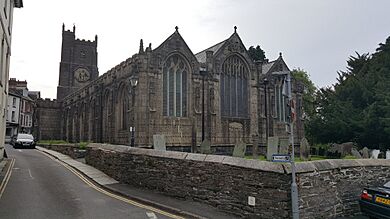
On St Stephen's Hill, there is a Roman Catholic church. It is dedicated to Cuthbert Mayne. It was built in 1911 and designed in a mix of Byzantine and Romanesque styles. The lady chapel was added in 1933.
Cornish Wrestling in Launceston
Launceston has been a centre for Cornish wrestling for many centuries. Tournaments were held in places like Castle Green, St Stephens, Chapman's Well, and the Bowling Green at Werrington Park.
Education in Launceston
There are five schools in Launceston:
- Four primary schools: St Catherine's Church of England Primary, St Stephen's Community Primary School, and Launceston Community Primary School (also known as Windmill Hill Academy). These schools are for children aged 4 to 11.
- St. Joseph's School on St Stephens Hill is a private school. It teaches boys and girls from age 3, from nursery up to the senior school.
- Launceston College was first started in 1409. It used to be a grammar school for boys. Now, it is a comprehensive school for all students aged 11 to 18 or 19.
A famous former student of Launceston College was the actor Sir Roger Moore. In the 1960s, two other schools, Horwell Grammar School for Girls and Pennygillam School, joined with Launceston College to form the school it is today. The college has been at the southern end of Dunheved Road since the 1800s.
Launceston Community Primary School is sometimes called Windmill Primary School. This is because it is next to the site of the town's old windmill in Coronation Park.
Transport in Launceston
Launceston is no longer connected to the national railway network. However, for almost 100 years, it had two railway lines. The Great Western Railway (GWR) line from Plymouth ended in the town. The London and South Western Railway (LSWR) line from Exeter to Padstow also passed through. The stations were next to each other. The GWR station closed to passengers in 1952. After that, all trains used the LSWR station until the line closed in 1966. The old station area has now been developed for light industry.
Currently, the closest train station to Launceston is Gunnislake, about 10 miles (16 km) away. The Launceston Steam Railway is a narrow-gauge heritage railway. It uses a nearby site and runs for 2.5 miles (4.0 km) west to Newmills, following the Kensey valley.
The closest main-line railway stations are Bodmin Parkway (about 24 miles or 39 km by car) and Plymouth (about 25.5 miles or 41 km). There are regular bus services from Launceston to Plymouth and Exeter St Davids railway station.
Notable Residents of Launceston
The writer and historian, Joan Rendell, lived near Launceston.
- Reverend Francis Vyvyan Jago Arundell was born in Launceston in 1780. He was a rector, an antiquary (someone who studies old things), and a traveller.
- Charles Causley, a famous poet.
- Mary Ann Davenport, an actress, born in Launceston in 1759.
- James Ruse, a Cornishman from Launceston. He arrived in New South Wales, Australia, in 1788 as part of the First Fleet of convict ships.
- John McGeoch, an important post-punk guitarist for bands like Magazine and Siouxsie and the Banshees.
- Sir Alfred Farthing Robbins, a journalist and writer, born in Launceston in 1856. He wrote Launceston, Past and Present.
- Philip Gidley King, the third Governor of New South Wales, born in Launceston in 1758.
Images for kids
-
Town centre in 1973 from Saint Stephen's Hill showing the prominent Launceston Castle
-
The market at Launceston (period 1850–98) by Francis Frith
-
St Mary Magdalene's Church, Launceston, Cornwall
See also
 In Spanish: Launceston (Cornualles) para niños
In Spanish: Launceston (Cornualles) para niños


